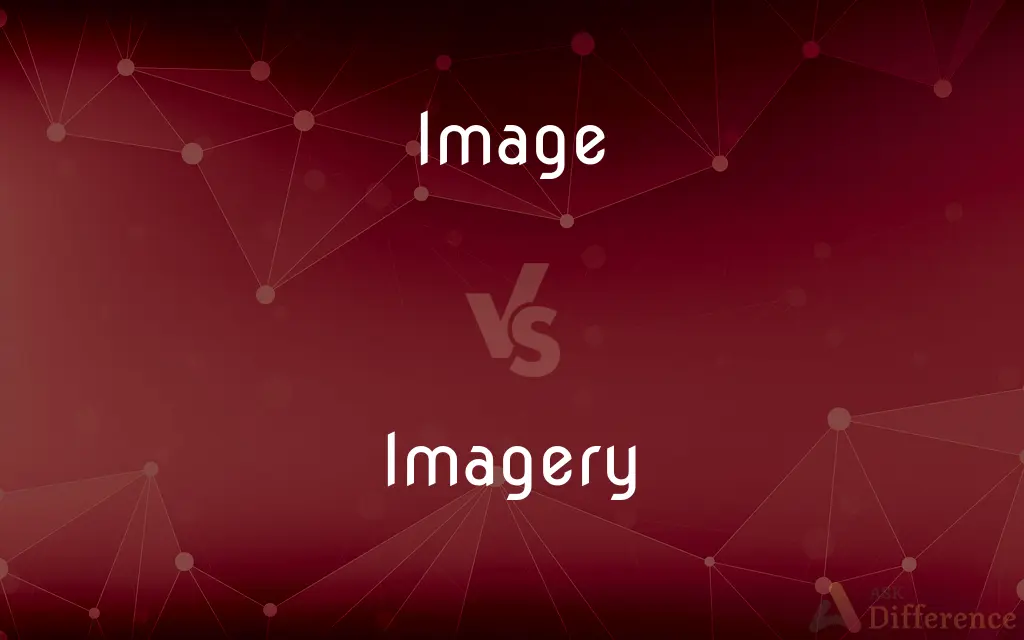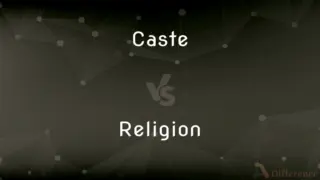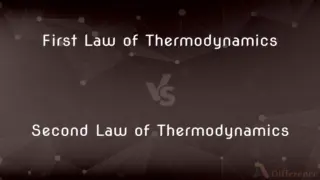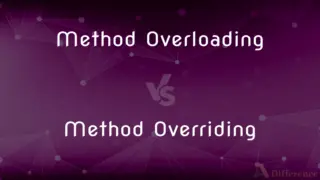Image vs. Imagery — What's the Difference?
Edited by Tayyaba Rehman — By Fiza Rafique — Updated on March 18, 2024
Image conveys a single visual representation, real or imagined, while imagery encompasses a collection of images used in language or art to evoke sensory experiences.

Difference Between Image and Imagery
Table of Contents
ADVERTISEMENT
Key Differences
Image refers to a single visual representation that can be seen directly or imagined, such as a photograph, painting, or mental picture. For example, a photograph of a sunset is an image capturing the colors and mood of that moment. Imagery, on the other hand, involves a collection of images, often used in literature, art, or speech to evoke a sensory experience. It's not limited to visual senses but can also include sound, taste, touch, and smell.
Image is specific and tangible, capturing a moment or concept in a defined form. Imagery is used to create a vivid experience for the reader or viewer, often evoking emotions or setting a mood. For instance, describing a scene with golden leaves, crisp air, and the smell of woodsmoke invokes autumn imagery.
While an image can stand alone as a single entity that communicates through its visual presence, imagery is dynamic and contextual, depending on the combination of images and the senses they aim to stimulate. An image might capture a moment in time, whereas imagery creates an immersive environment or feeling.
In the context of digital media, an image often refers to photographs, illustrations, and visual elements used on websites and in graphic design. These images are concrete, with specific dimensions and resolutions, tailored for visual impact or information sharing. Conversely, imagery in digital media can refer to the thematic use of visual elements to create a certain atmosphere or brand identity. This could include a consistent use of colors, styles, and motifs that evoke specific feelings or messages, demonstrating how imagery works on a more abstract level than individual images.
Comparison Chart
Definition
A single visual representation.
A collection of images evoking sensory experiences.
ADVERTISEMENT
Usage
Concrete, individual visual entities.
Abstract, evokes emotions or sensations.
Sensory Appeal
Primarily visual.
Can involve all senses: visual, auditory, olfactory, gustatory, and tactile.
Context
Can be standalone.
Often used in combination for greater effect.
Example in Digital Media
A specific photo or graphic on a website.
The overall visual theme of a website evoking a specific mood.
Compare with Definitions
Image
A visual representation in science or mathematics.
The microscope produced a clear image of the cell.
Imagery
The employment of metaphors and similes to paint pictures in the mind.
His speech was rich in imagery, making his points come alive.
Image
A graphical representation in art.
The artist's image of the sea was stunningly realistic.
Imagery
The use of descriptive language to create sensory experiences.
The poet's imagery transported readers to a serene landscape.
Image
A mental picture formed in the mind.
The story conjured a vivid image of the ancient city.
Imagery
Visual symbolism in art or literature.
The film used dark imagery to evoke feelings of despair.
Image
A figure or likeness of a person.
The sculpture was an exact image of the historical figure.
Imagery
The technique of creating vivid, sensory experiences in writing.
Her use of imagery made the characters and settings jump off the page.
Image
A photograph captured by a camera.
The image of the mountain was breathtaking.
Imagery
A series of images forming a theme in literature.
The novel's war imagery was both vivid and harrowing.
Image
An image (from Latin: imago) is an artifact that depicts visual perception, such as a photograph or other two-dimensional picture, that resembles a subject—usually a physical object—and thus provides a depiction of it. In the context of signal processing, an image is a distributed amplitude of color(s).
Imagery
Part of the figurative language in a literary work, whereby the author uses vivid images to describe a phenomenon
Image
A representation of the external form of a person or thing in art
Her work juxtaposed images from serious and popular art
Imagery
Visually descriptive or figurative language, especially in a literary work
Tennyson uses imagery to create a lyrical emotion
Image
The general impression that a person, organization, or product presents to the public
She strives to project an image of youth
Imagery
Visual images collectively
The impact of computer-generated imagery on contemporary art
Image
A simile or metaphor
He uses the image of a hole to describe emotional emptiness
Imagery
A set of mental pictures or images.
Image
Make a representation of the external form of
Artworks which imaged women's bodies
Imagery
The use of vivid or figurative language to represent objects, actions, or ideas.
Image
A representation of the form of a person or object, such as a painting or photograph.
Imagery
The use of expressive or evocative images in art, literature, or music.
Image
A sculptured likeness.
Imagery
A group or body of related images, as in a painting or poem.
Image
(Physics) An optically formed duplicate, counterpart, or other representative reproduction of an object, especially an optical reproduction formed by a lens or mirror.
Imagery
Representative images, particularly statues or icons.
Image
One that closely or exactly resembles another
He is the image of his uncle.
Imagery
The art of making such images.
Image
Likeness; semblance
Genesis says that man was made in the image of God.
Imagery
(Psychology) A technique in behavior therapy in which the patient uses pleasant fantasies to relax and counteract anxiety.
Image
The opinion or concept of something that is held by the public
The public's image of business leaders as greedy.
Imagery
The work of one who makes images or visible representation of objects.
Image
The concept or character projected to the public, as by a person or institution, especially as interpreted by the mass media
An actor who tried to convey an image of refined beauty.
Imagery
Imitation work.
Image
A typical example or embodiment
That child is the image of good health.
Imagery
Images in general, or en masse.
Image
A mental picture of something not real or present
Our image of the cottage did not conform with reality.
Imagery
(figuratively) Unreal show; imitation; appearance.
Image
A vivid description or representation in words, especially a metaphor or simile
The poem uses the image of a barren tree to convey feelings of desolation.
Imagery
The work of the imagination or fancy; false ideas; imaginary phantasms.
Image
(Mathematics) A set of values of a function corresponding to a particular subset of a domain.
Imagery
Rhetorical decoration in writing or speaking; vivid descriptions presenting or suggesting images of sensible objects; figures in discourse.
Image
(Computers) An exact replica of the contents of a storage device, such as a hard disk, stored on a second storage device, such as a network server.
Imagery
The work of one who makes images or visible representation of objects; imitation work; images in general, or in mass.
In those oratories might you seeRich carvings, portraitures, and imagery.
Image
(Obsolete) An apparition.
Imagery
Fig.: Unreal show; imitation; appearance.
What can thy imagery of sorrow mean?
Image
To make or produce a likeness of
Imaged the poet in bronze.
Imagery
The work of the imagination or fancy; false ideas; imaginary phantasms.
The imagery of a melancholic fancy.
Image
To mirror or reflect
A statue imaged in the water.
Imagery
Rhetorical decoration in writing or speaking; vivid descriptions presenting or suggesting images of sensible objects; figures in discourse.
I wish there may be in this poem any instance of good imagery.
Image
To make a visual representation of (an object) using remote scanning or technology such as magnetic resonance imaging
Imaged the diseased kidneys.
Imaged the surface of Mars.
Imagery
The ability to form mental images of things or events;
He could still hear her in his imagination
Image
To symbolize or typify
A kneeling woman imaging the nation's grief.
Image
To picture mentally; imagine or visualize
Imaged each dive before doing it.
Image
To describe, especially so vividly as to evoke a mental picture
The passage images what it's like to grow up poor.
Image
To print (a file) using a laser printer, imagesetter, direct-to-plate press, or similar device.
Image
To transmit (an exact replica of the contents of a storage device) to another storage device
Imaged the hard drive to the server.
Image
An optical or other representation of a real object; a graphic; a picture.
The Bible forbids the worship of graven images.
Image
A mental picture of something not real or not present.
Image
A statue or idol.
Image
(computing) A file that contains all information needed to produce a live working copy. (See disk image and image copy.)
Most game console emulators do not come with any ROM images for copyright reasons.
Image
A characteristic of a person, group or company etc., style, manner of dress, how one is or wishes to be perceived by others.
Image
(mathematics) What a function maps to.
The number 6 is the image of 3 under f that is defined as f(x) = 2x.
Image
(mathematics) The subset of a codomain comprising those elements that are images of something.
The image of this step function is the set of integers.
Image
(radio) A form of interference: a weaker "copy" of a strong signal that occurs at a different frequency.
Image
(obsolete) Show; appearance; cast.
Image
(transitive) To represent by an image or symbol; to portray.
Image
(transitive) To reflect, mirror.
Image
(transitive) To create an image of.
Image
To create a complete backup copy of a file system or other entity.
Image
An imitation, representation, or similitude of any person, thing, or act, sculptured, drawn, painted, or otherwise made perceptible to the sight; a visible presentation; a copy; a likeness; an effigy; a picture; a semblance.
Even like a stony image, cold and numb.
Whose is this image and superscription?
This play is the image of a murder done in Vienna.
And God created man in his own image.
Image
Hence: The likeness of anything to which worship is paid; an idol.
Thou shalt not make unto thee any graven image, . . . thou shalt not bow down thyself to them.
Image
Show; appearance; cast.
The face of things a frightful image bears.
Image
A representation of anything to the mind; a picture drawn by the fancy; a conception; an idea.
Can we conceiveImage of aught delightful, soft, or great?
Image
A picture, example, or illustration, often taken from sensible objects, and used to illustrate a subject; usually, an extended metaphor.
Image
The figure or picture of any object formed at the focus of a lens or mirror, by rays of light from the several points of the object symmetrically refracted or reflected to corresponding points in such focus; this may be received on a screen, a photographic plate, or the retina of the eye, and viewed directly by the eye, or with an eyeglass, as in the telescope and microscope; the likeness of an object formed by reflection; as, to see one's image in a mirror.
Image
To represent or form an image of; as, the still lake imaged the shore; the mirror imaged her figure.
Image
To represent to the mental vision; to form a likeness of by the fancy or recollection; to imagine.
Condemn'd whole years in absence to deplore,And image charms he must behold no more.
Image
An iconic mental representation;
Her imagination forced images upon her too awful to contemplate
Image
A visual representation (of an object or scene or person or abstraction) produced on a surface;
They showed us the pictures of their wedding
A movie is a series of images projected so rapidly that the eye integrates them
Image
(Jungian psychology) a personal facade that one presents to the world;
A public image is as fragile as Humpty Dumpty
Image
A standard or typical example;
He is the prototype of good breeding
He provided America with an image of the good father
Image
Language used in a figurative or nonliteral sense
Image
Someone who closely resembles a famous person (especially an actor);
He could be Gingrich's double
She's the very image of her mother
Image
A representation of a person (especially in the form of sculpture);
The coin bears an effigy of Lincoln
The emperor's tomb had his image carved in stone
Image
Imagine; conceive of; see in one's mind;
I can't see him on horseback!
I can see what will happen
I can see a risk in this strategy
Common Curiosities
Is an image always visual?
While typically visual, the term "image" can also refer to mental pictures formed in the imagination.
How does imagery enhance a reader's experience?
By evoking sensory experiences, imagery helps create a vivid, immersive environment in the reader's mind.
How is imagery used in advertising?
To create a mood or feeling that associates a product with positive sensory experiences.
What is the difference between digital images and traditional paintings?
Digital images can be easily edited and shared, while traditional paintings involve physical materials and techniques.
Can images be misleading?
Yes, images can be manipulated or taken out of context, leading to misunderstandings.
How do images contribute to learning?
Images can aid memory and understanding by providing visual context or illustrating concepts.
Can the absence of imagery be powerful in a narrative?
Yes, the absence of detailed imagery can create ambiguity or focus attention on other elements like dialogue or action.
What is the primary function of an image?
To provide a visual representation of an object, scene, or concept.
Can imagery be found in everyday language?
Yes, imagery can be found in everyday language, especially in descriptive narratives or expressions.
Why is imagery important in literature?
It deepens the reader's understanding and connection to the text by engaging the senses.
What types of imagery are there?
Visual, auditory, olfactory (smell), gustatory (taste), and tactile (touch).
Can imagery be used to evoke negative emotions?
Yes, imagery can be used to evoke a wide range of emotions, including negative ones like fear or sadness.
Is an image the same as an icon?
Not exactly; an icon is a symbolic image representing a concept, application, or function, often simplified, while an image can be more detailed and realistic.
What role does imagery play in film?
It sets the tone, supports the narrative, and evokes emotional responses from the audience.
How do images affect social media engagement?
Posts with images tend to receive more engagement (likes, shares, comments) than those without.
Share Your Discovery

Previous Comparison
Caste vs. Religion
Next Comparison
Purine vs. PyrimidineAuthor Spotlight
Written by
Fiza RafiqueFiza Rafique is a skilled content writer at AskDifference.com, where she meticulously refines and enhances written pieces. Drawing from her vast editorial expertise, Fiza ensures clarity, accuracy, and precision in every article. Passionate about language, she continually seeks to elevate the quality of content for readers worldwide.
Edited by
Tayyaba RehmanTayyaba Rehman is a distinguished writer, currently serving as a primary contributor to askdifference.com. As a researcher in semantics and etymology, Tayyaba's passion for the complexity of languages and their distinctions has found a perfect home on the platform. Tayyaba delves into the intricacies of language, distinguishing between commonly confused words and phrases, thereby providing clarity for readers worldwide.
















































